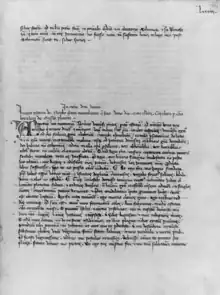Gabriel de Mussis
Gabriel de Mussis (ca. 1280 – ca. 1356) — in Italian, Gabriele de' Mussi — was a notary from Piacenza, Italy, who gave a vivid account of the start of the Black Death in the Black Sea city of Kaffa and its spread to Sicily and Piacenza. His account in Latin, entitled Istoria de Morbo sive Mortalitate quae fuit Anno Dni MCCCXLVIII ("History of the Disease, or the Great Dying that took place in the Year of our Lord 1348"), is preserved in a manuscript in the library of the University of Wroclaw (now shelfmark R 262).[1]

Although it was formerly believed that de Mussis had been present in Kaffa and travelled in a disease-laden ship to Piacenza, it has been determined that he probably never left home. De Mussis apparently recorded an early example of biological warfare in describing how the army of the Golden Horde hurled plague-infected cadavers over the city walls during the Siege of Caffa in 1346. Modern authorities believe that his description of events is plausible and may indicate that plague was successfully introduced into Kaffa by the Tartars, but that the long-standing belief that the events at Kaffa contributed to the spread of plague beyond the city is not correct.[1] Some scholars such as Jean Paul Zanders however believe that the story of the attack as exaggerated due to factors such as De Mussis only hearing of the attack from others and the limitations of trebuchet capabilities.[2]
References
Citations
- Mark Wheelis (2002), “Biological Warfare at the 1346 Siege of Caffa”, Emerging Infectious Diseases, Vol. 8, No. 9 (September issue).
- Field, Matt (August 10, 2023). "Catapulting corpses? A famous case of medieval biological warfare probably never happened". Bulletin of the Atomic Scientists. Bulletin of the Atomic Scientists. Retrieved August 10, 2023.
Other sources
- Deaux, George (1969), The Black Death 1347. New York: Weybright and Talley; Chapter IV, pp. 75ff.
- Derbes, Vincent J. (April 4, 1966), “De Mussis and the Great Plague of 1348”, JAMA. 1966; 196(1):59-62. doi:10.1001/jama.1966.03100140113030.